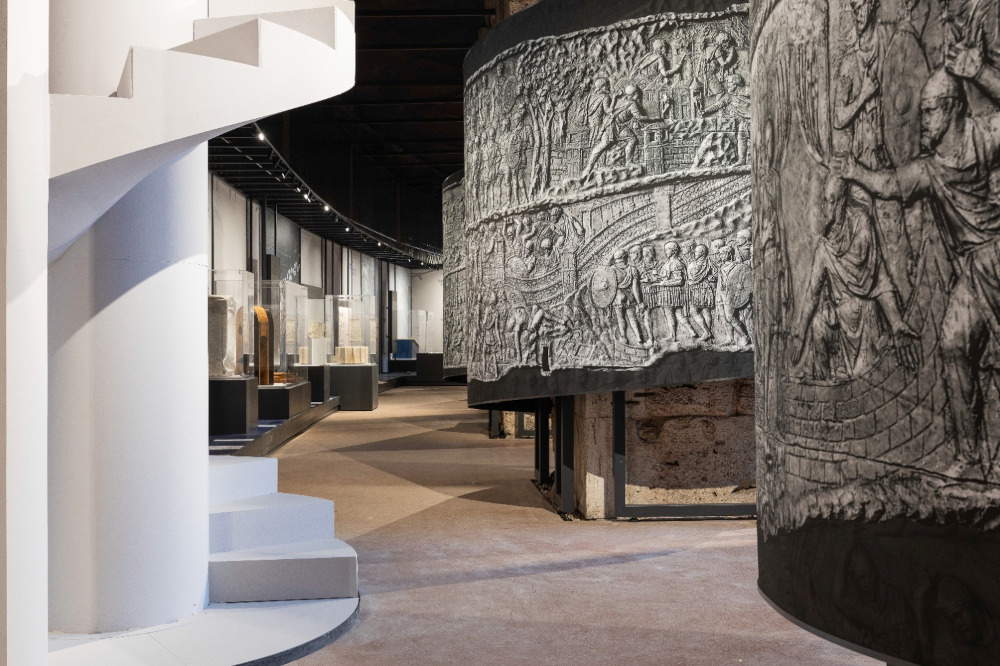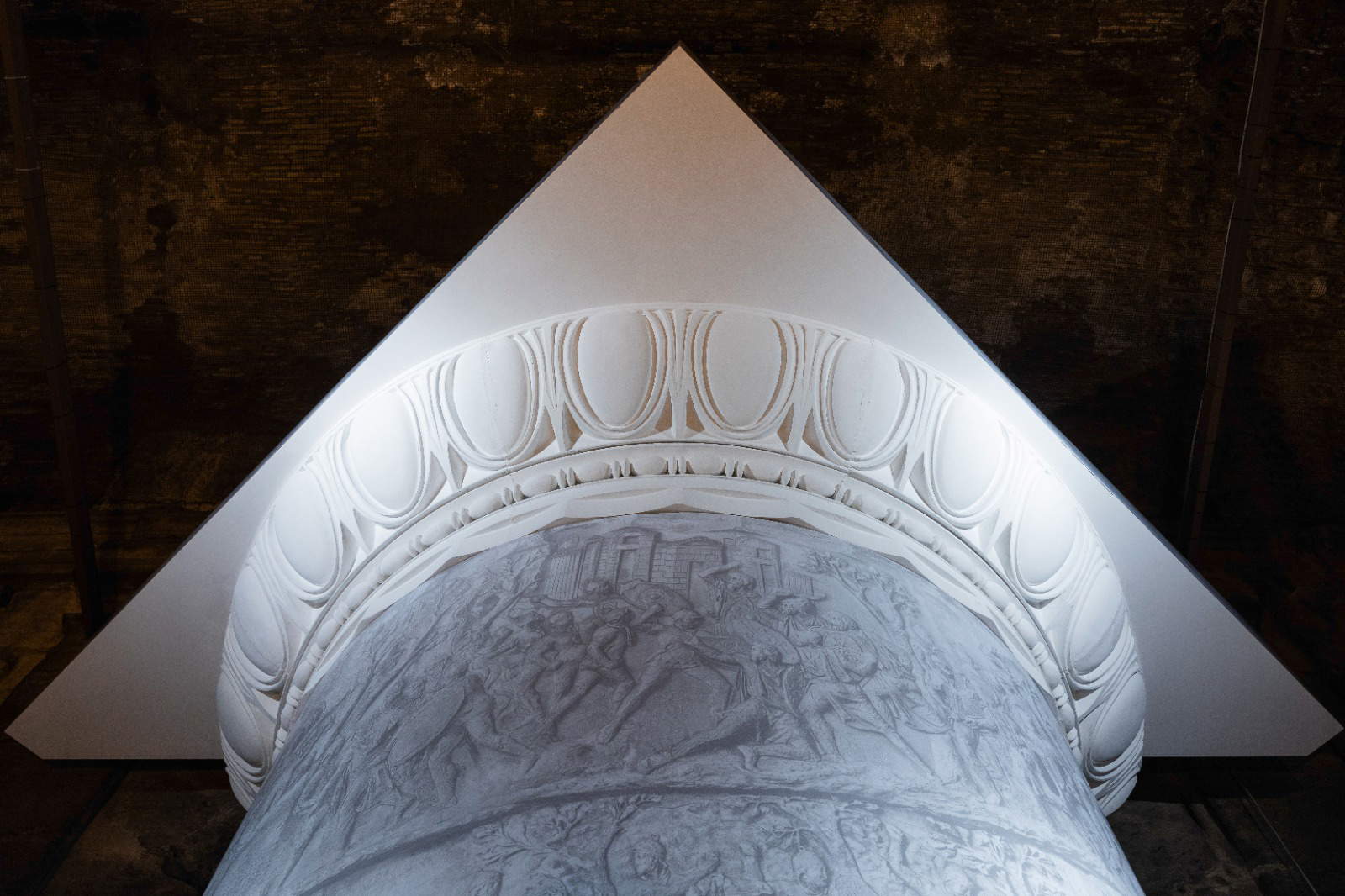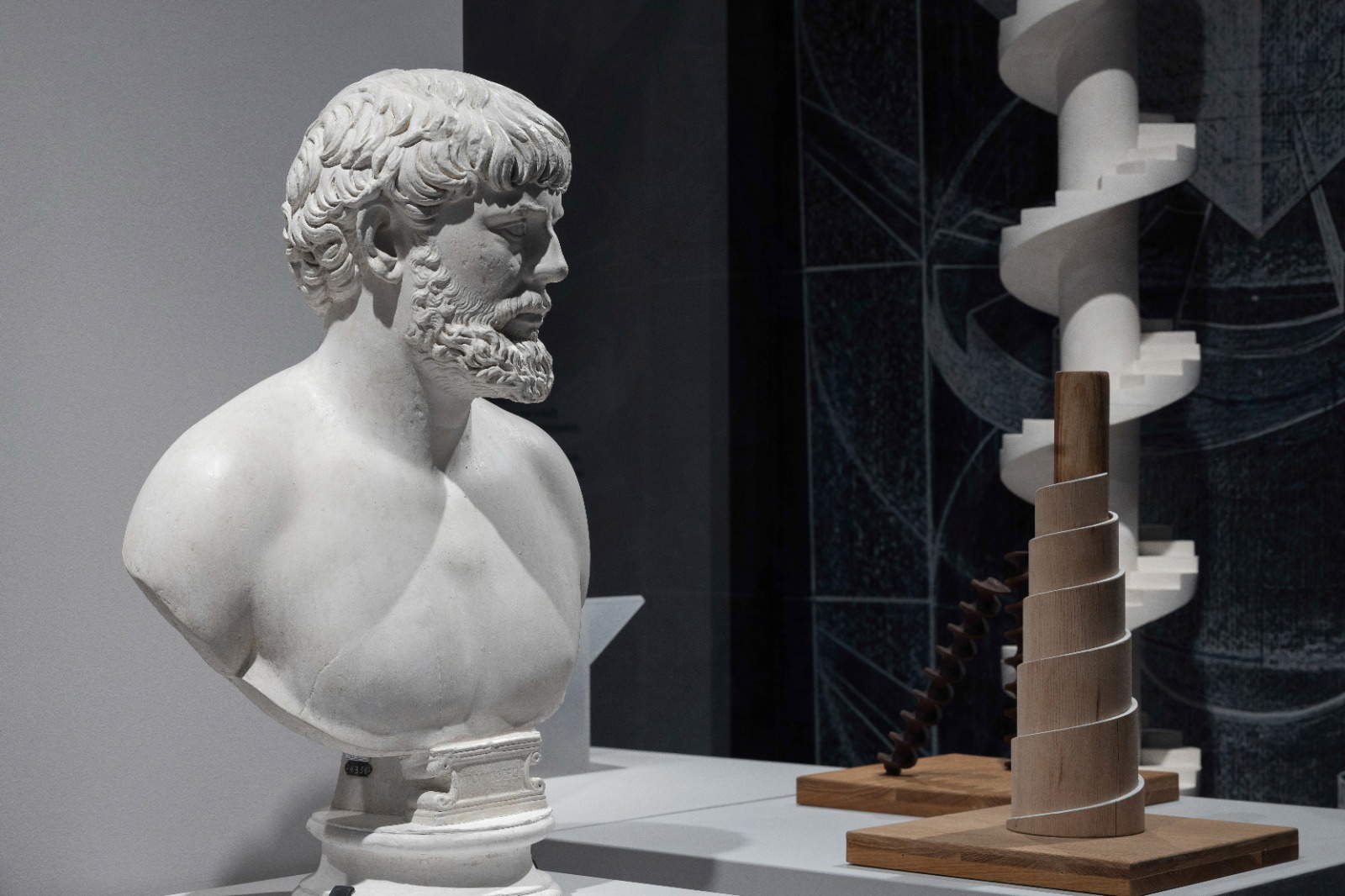An exhibition telling the story of Trajan's Column opens at the Colosseum
From December 22, 2023 to April 30, 2024, the second order of the Colosseum is open to visitors The Trajan Column. The Tale of a Symbol, curated by i and Giovanni Di Pasquale, organized and promoted by the Colosseum Archaeological Park and the Galileo Museum -Institute and Museum of the History of Science.
Trajan’s Column was inaugurated on May 12, 113 AD, 1910 years ago. Since its design and construction, the Column represented a challenge to human ingenuity: the extraction of marble from the Carrara quarry, its transport by land, sea, and river, and its fabrication and installation at the site of the Forum of Trajan constituted the stages of a complex engineering and technological process. At the Forum building site, the Column, shortly thereafter wrapped in a spiral frieze celebrating the glorious Dacian campaigns of Optimus Princeps Trajan, was excavated to make a spiral staircase, and the marble structure was hollowed out from the inside. It was Apollodorus of Damascus, an ingenious and innovative architect and engineer of Syrian origin, who illustrated to Trajan the design of the Column against the backdrop of the Apuan Alps, in the tapestry from the Ouderarde manufactory, displayed in the exhibition in its digitized version.
The cast of the bust attributed to Apollodorus from the Museum of Roman Civilization and that of Trajan from the Palatine Museum, along with styles and tools for writing and drawing and the scale model of the bridge over the Danube, introduce the visitor to the workshop of the master architect.
In order to understand the process of building the Column and the physical labor of hundreds of men that went into its construction, the main ancient tools used for extracting the marble blocks, transporting them by boat and putting them in place are displayed, with reconstructive models of the construction machinery of the time, such as cranes, towers, wheels, made by Claudio Capotondi, a novice “Master of Trajan’s Enterprises.”
This story is also told visually in the exhibition through videos and screen projections made by the Museo Galileo. Also contributing to the permanent story of the Column is a webAPP in Italian and English and, thanks to the collaboration of the Romanian Embassy, also in Romanian.
Theinstallation aims to narrate and explain the universal symbolic function of the Column with two narrative registers: the more properly historical and artistic one, with the reconstruction of the frieze on a scale of 1:1 whose coils coil over the pillars of the Colosseum, separated in the narrative of the First and Second Dacian Wars by the Victory writing on the shield reproduced in the cast in the Vatican Museums; and the more specifically technical one, with the stages of the marble’s working, up to the idolatry and political use of the sovereigns of Europe who demanded its reproduction through the technique of calcination.
In fact, the symbolic function of this work translates very early on into its replicability, and as recounted in the last section, today the heritage of drawings, prints, and reproductions, but above all the heritage of casts that from the mid of the 16th century and up to the 20th century have invaded Europe, the courts and the collections of the major museums of France, Romania, and Italy, thus testifying to the fortunes of the Column, from political monument, to object of strong educational and educational value, to the fate of replication and copying.
From the cast, as a work of art in itself as a witness to a technological process of reproducing a model, to the cast, as a witness to the passage of time on the surfaces of the Column over the centuries, springs the image of a unique and unrepeatable monument and for this reason the object now for fortyyears of restoration and maintenance, but also of extensive campaigns of photographic documentation, surveys and 3D photogrammetric shots, of which the immersive chamber at the end of the visit route conceived and realized by Sergio Fontana aims to offer a suggestion. Visitors will be immersed here in the landscapes of 2nd century AD Dacia, and will be able to admire the frieze of the Column in life-size, high quality images.



“The Trajan’s Column is the gateway to the Colosseum Archaeological Park; it is located at the start of that path that, with a single walkway, now joins the Forum of Trajan and that of Caesar with the Roman Forum and the Palatine up to the Colosseum,” commented Park Director Alfonsina Russo. “But the Column, erected to celebrate the exploits of Trajan and the greatest expansion of the Roman Empire, today is also a symbol of Europe as evidenced by its widespread ’presence’ in the collections of major European museums. And it is a source of pride to continue the path of knowledge, protection and enhancement of such an iconic monument, contributing to its fortune over time.”
“This exhibition has a twofold significance,” explains Federica Rinaldi, archaeologist in charge of the project and co-curator, “on the one hand, thanks to the initial idea and the scientific support of Museo Galileo and maestro Claudio Capotondi, it explores with a strong didactic slant and anaccessibility for all to the fascinating topic of how monuments were built in the Roman age, exposing ancient tools and machines used in the construction sites of the time in a continuous game of mirrors between ancient sources and contemporary reconstructions; on the other, it is placed at the beginning of a path of study, research and valorization that with Angelica Pujia, co-curator of the project, has been conceived to read the material and therefore the conservative state of the historic frieze through the maintenance activities already scheduled until 2026, but also and above all with an expanded look at the fortunes of the Column from the 16th century onward thanks to the historical documentation consisting of casts, drawings, prints and reproductions.”
“The Trajan Column is a work of engineering of unprecedented complexity, testifying to the very high heights reached by Roman civilization in the art of building,” added Giovanni Di Pasquale, deputy scientific director of the Museo Galileo and co-curator of the exhibition project. “The exhibition recounts the toil and ingenuity of men who extracted tons of marble and then tackled the nearly 700 meters of difference in height with sturdy wooden sleds to reach the plain and the port of Luni, where huge ships were ready to reach Ostia and Rome. It is difficult today to imagine the organization of such a complex construction site and the mechanical precision required to compose the monument, with its blocks precisely juxtaposed one on top of the other and the steps of the inner staircase fitting together perfectly. If the knowledge that made it possible to complete all the stages of this undertaking, never recorded in written form, vanished with the end of the civilizations that put them in place, the dialogue between literary and archaeological sources makes it possible to recompose this extraordinary adventure. To achieve this, the exhibition itinerary is punctuated by the presence of archaeological artifacts, machine models, 3-D reconstructions and multimedia insights: the result is a narrative that will allow us to reflect on the fundamental, and poorly known, role played by scientific and technological knowledge in the development of Roman civilization.”
Born out of the collaboration agreement between the Colosseum Archaeological Park and the Galileo Museum, Institute and Museum of the History of Science in Florence and the agreement between the Colosseum Archaeological Park and the Capitoline Superintendence for Cultural Heritage, this exhibition thus aims to propose with a new key of interpretation, and with a look up to the contemporary, the events of the construction and fortune of the Column.
Guided by Apollodorus, the exhibition traces in three sections the stages of the construction of the Column, dwelling on the form and technique with which it was made. It explains and illustrates, also with a didactic slant, the process of the monument’s construction, using reconstructive models, not only of the Column itself (among them the sommoscape and the internal spiral staircase in Room 1:1 made by Opera Laboratori Fiorentini), but also of the machines for dragging and lifting the colossal blocks, as well as of the ropes and coupling systems, in a constant dialogue with literary sources, archaeological and iconographic finds and tools (compasses, squares, winches, cranks, plumb lines) found in excavation contexts and referable to them.
It also aims to tell the story of the Column’s eternity, and for the realization of this illustrated tale, wrapped in the color blue to echo the Danube but also the interaction between Man and Technology, twenty public and private institutions and entities have contributed, lending more than sixty objects including artifacts, models, machines, casts, and drawings.
The exhibition is accompanied by a registry with panels and in-depth texts accompanied by unpublished images and a bibliographical appendix summarizing the main scientific publications devoted to the Column in recent years, represented by exhibition catalogs, miscellany of studies, and collections of scientific essays. Themed lectures, dedicated podcasts and a study day in the spring to take stock of the latest research, conservation issues and the subject of casts will also be scheduled during the duration of the exhibition.
For info: www.colosseo.it
Pictured is a view of the exhibition set-up. Photo by Colosseum Archaeological Park.
 |
| An exhibition telling the story of Trajan's Column opens at the Colosseum |
Warning: the translation into English of the original Italian article was created using automatic tools. We undertake to review all articles, but we do not guarantee the total absence of inaccuracies in the translation due to the program. You can find the original by clicking on the ITA button. If you find any mistake,please contact us.





























